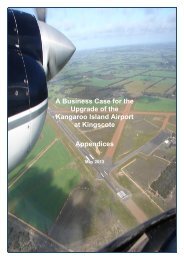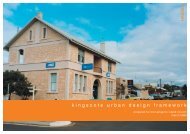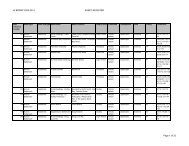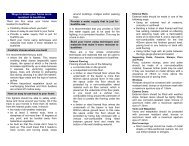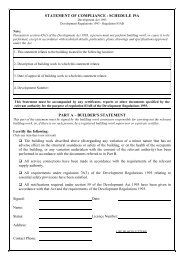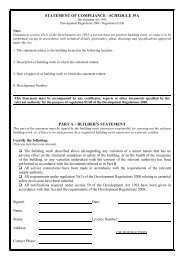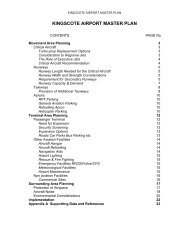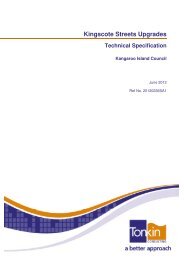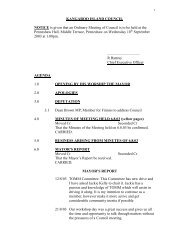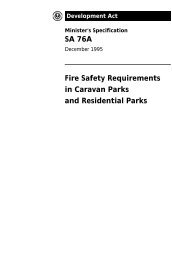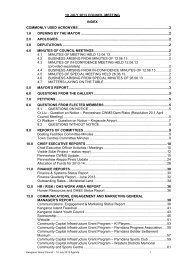Tourism Development - a checklist for proponents - Kangaroo Island ...
Tourism Development - a checklist for proponents - Kangaroo Island ...
Tourism Development - a checklist for proponents - Kangaroo Island ...
You also want an ePaper? Increase the reach of your titles
YUMPU automatically turns print PDFs into web optimized ePapers that Google loves.
Checklists <strong>for</strong> PlanningA tool <strong>for</strong> <strong>proponents</strong> of <strong>Tourism</strong><strong>Development</strong>Exert from the <strong>Kangaroo</strong> <strong>Island</strong> Strategic <strong>Tourism</strong> PlanPrepared June 2006Adopted January 2007A Joint initiative of:
Principles of Sustainable <strong>Tourism</strong>Principles of Sustainable <strong>Tourism</strong>, Sustainable <strong>Tourism</strong> Package, Prepared by the<strong>Tourism</strong> Policy and Planning Group (SATC) <strong>for</strong> the SATCThe following 12 principles, based on the triple bottom line are intended toguide South Australia’s <strong>Tourism</strong> Strategy. These are:1. Being different from other competing destinations (achieved bybasing development and marketing on the attributes andstrengths of the destination);2. Achieving authenticity by being genuinely relevant to the history, industry,culture, lifestyle and natural resources of the district;3. Reflecting community values by representing the past, presentand future aspirations of the local community in a living anddynamic way (achieved by listening to and responding to thecommunity);4. Understanding and targeting the market (broad market trends and theneeds of specific market segments) by developing specialised productsbased on the inherent attributes of an area;5. Enhancing the experience <strong>for</strong> travellers by providing them withsomething they cannot experience at home (achieved by‘bundling’ attributes to enhance the appeal of a place and thelikelihood of visitation);6. Adding value to existing area attributes to realise a richer tourismexperience and diversify the local economy (achieved byincluding accommodation, sales outlets, conference facilitiesand dining in association with established industries);7. Respecting natural and cultural venues which <strong>for</strong>ms the basis ofsustainable tourism development and importantly respectsecological processes;8. Achieving conservation outcomes through developing mutuallybeneficial partnerships between tourism and conservation;9. Having good ‘content’ (‘telling the story’) by interpreting(presenting and explaining) natural, social, historic andecological features;10. Achieving excellence and innovation in design by respecting the resource,reflecting community values, being able to ‘tell the story’ and achievinggood conservation outcomes;11. Providing mutual benefits to visitors and hosts by promotingeconomic and community development <strong>for</strong> the benefits of boththe host community and visitor;12. Building local capacity by integrating tourism businesses with thelocal communities they operate within.
Checklists <strong>for</strong> Property Owners Planning a <strong>Tourism</strong><strong>Development</strong>Are you thinking of buying property to use <strong>for</strong> tourism purposes?Do you own land that you would like to develop <strong>for</strong> tourism accommodation?If you answered yes to one of these questions then Part A of this <strong>checklist</strong> isintended to assist you in addressing those matters required as part of your planningapplication.Part B of the <strong>checklist</strong> is designed to help you get the right advice to give you thebest chance of establishing a successful business.Contact details <strong>for</strong> the organisations mentioned are provided in Part C.PART A: ENVIRONMENT, INFRASTRUCTURE AND AMENITYQUESTIONSAbout the SiteWhat are the main conservation values of the siteand adjoining land? What impacts could yourdevelopment have and how will you managethese?Will this development require a change of landuse? Is this a permitted activity <strong>for</strong> this zone?KEY CONTACTDepartment <strong>for</strong>Environment and Heritage(DEH) KI NRM BoardKI CouncilWill you need to clear native vegetation?How will you manage bushfire risk?What impacts will your development have onwater resources?Infrastructure AvailabilityDoes the site have adequate power supply tomeet the needs of the development?Is the volume and pressure of mains wateradequate? What rainwater storage capacity willyou need <strong>for</strong> the size of your development?Native Vegetation CouncilCFSKI Natural ResourceManagement BoardETSA UtilitiesSA Water KI NRM Board KICouncilHow will you manage wastewater on the site?How will you manage stormwater run-off leavingthe site?KI CouncilKI Council KI NRM BoardQUESTIONSSite Planning and DesignWhat is the nature of adjoining land, eg,conservation values, land uses? How will youachieve access to the site?KEY CONTACTDEH / KI Council KI NRMBoard KI Council orTransport Department
PART C: CONTACT DETAILS FOR ORGANISATIONS WHO CAN PROVIDEINFORMATION, ADVICE AND SUPPORTKIDBKI Council<strong>Kangaroo</strong> <strong>Island</strong> <strong>Development</strong> BoardPhone: 8553 3211Email: kidb@kin.net.au<strong>Kangaroo</strong> <strong>Island</strong> CouncilPhone: 8553 2015Email: kicouncil@kicouncil.sa.gov.auTKI<strong>Tourism</strong> <strong>Kangaroo</strong> <strong>Island</strong>Phone: 8553 1185DEHTOMMKINRM BoardSATCVegetationClearanceCFSElectricityMains WaterDTEIEPAESCOSAEmail: marketing@tourkangarooisland.com.auDepartment <strong>for</strong> Environment and HeritagePhone: 8553 2381<strong>Tourism</strong> Optimisation Management ModelPhone: 8553 4518Email: info@tomm.info<strong>Kangaroo</strong> <strong>Island</strong> Natural Resources ManagementBoardPhone: (08) 8553 0111Email: info.kinrmboard@bigpond.comSouth Australian <strong>Tourism</strong> Commission, Planning andPolicy UnitPhone: 8463 4500Native Vegetation CouncilPhone: 8124 7400CFS Planning and <strong>Development</strong>Phone: 8339 6900Email: www.cfs.org.auETSA UtilitiesPhone: 13 12 61SA WaterPhone: 8204 1000Email: customerservice@sawater.com.auDepartment of Transport, Energy and InfrastructurePhone: 13 10 84Environment Protection AuthorityPh one: 8204 2000Essential Services Commission SA(Regulatory body <strong>for</strong> energy)Phone: 8463 4444
Checklist <strong>for</strong> Planning and Design of <strong>Tourism</strong> <strong>Development</strong>s inNatural EnvironmentsThe Design Guidelines <strong>for</strong> Sustainable <strong>Tourism</strong> <strong>Development</strong> prepared by the SouthAustralian <strong>Tourism</strong> Commission are accessible on www.tourism.sa.gov.au / tourism.These Guidelines provide details on all of the natural resource elements andsystems to be addressed in the location and design of tourism developments.These are applicable to any site. Locations in natural environments require evengreater attention to detail.Land is made up of a number of elements and systems that interact to <strong>for</strong>m naturallandscapes. The <strong>checklist</strong> below provides examples of a range of issues that needto be addressed, the primary sources of in<strong>for</strong>mation about that issue and possibleresponses at the planning, construction and operational stage.HYDROLOGY – Surface and groundwater flows and rainfall / stormwater flowsExamples of Issues <strong>for</strong><strong>Development</strong>Increased surface water runoffand risk of erosion Interruptionsto and decrease in naturalflow regimes Pollution of watersourcesSOILSLoss of topsoil and essentialnutrients Spread of soil bornedisease, eg, phytophoraKey In<strong>for</strong>mationSourceDWLBC KI NRMBoard DWLBC KINRM BoardDWLBC, EPA KINRM BoardKI NRM Board KINRM BoardDesirable ResponseInstall rainwater tanks or otherstorage devices Avoid /minimise changes in flowregimes or remediate flowsdownstream of any structuresAvoid or minimise use ofchemicalsLimit clearance of vegetationand/or site excavations.Revegetate with localindigenous species. Implementeffective machinery hygienepractices. Minimise disturbanceby foot and vehicle traffic.VEGETATIONExamples of Issues <strong>for</strong><strong>Development</strong>Vegetation clearance orremoval Potential impacts onhabitat of rare andendangered species Weedinvasion or spread of existingweedsFAUNA Potential impacts onnative fauna, eg, throughinterference with their habitat,movement corridors Seasonalimpacts at times of nestingand breeding Humanbehaviour can modify speciesbehaviour and leave themvulnerableKey In<strong>for</strong>mationSourceNativeVegetationCouncil DEH,EnvironmentAustralia <strong>for</strong>nationallyendangeredspecies KI NRMBoardDEH KI NRMBoard DEH KINRM Board DEHDesirable ResponseNative vegetation in SouthAustralia is protected by law.Seek advice if proposeddevelopment is in or nearnative vegetation. If limitedclearance is required, offset byvegetation conservationinitiatives to ensure netbiodiversity gain. Identify andprotect any areas ofvegetation significance andsignificant or endangeredspecies.Identify and protect importantfauna habitat and threatenedspecies. Exclude or restrictaccess to these areas atsensitive times <strong>for</strong> identifiedspecies. Do not <strong>for</strong>ceinteraction with animals or feedthem to encouragedependency.
BUSHFIRE PROTECTIONPotential conflict betweenrequirements <strong>for</strong> clearance ofvegetation around buildingsand minimising impacts onvegetation and providingquality visitor experienceCFS,<strong>Development</strong>Assessment UnitInvestigate and install bothpassive and active fireprotection measures. Ensureregular monitoring andmaintenance.TOPOGRAPHYExamples of Issues <strong>for</strong><strong>Development</strong>Extensive cut and fill on slopingsites increases risk tovegetation and fauna habitatand can lead to loss of topsoiland unsightly erosionKey In<strong>for</strong>mationSourceKI NRM BoardArchitects andDesignProfessionalswith expertiseon sloping sites.SATC Planning& Policy UnitPossible ResponseDesign buildings that work withthe slope of the land tominimise cut and fill.KEY CONTACTS ON KANGAROO ISLANDVegetation, FaunaDEH (Department <strong>for</strong> Environment and Heritage)Phone: 8553 2381VegetationClearanceNative Vegetation CouncilPhone: 8124 4700WaterDWLBC (Department of Water, Land andBiodiversityConservation)Phone: 8553 0111Soils, WeedManagementKINRM (<strong>Kangaroo</strong> <strong>Island</strong> Natural ResourceManagement Board)Phone: 8553 0111Bushfire Prevention CFS <strong>Development</strong> Assessment Unit –www.cfs.org.auPhone: 8339 6900Topography SATC Planning and Policy Unit –www.tourism.sa.gov.au / tourismPhone: 8463 4500Architects andDesignProfessionalsRoyal Australian Institute of ArchitectsPhone: 8228 9100



